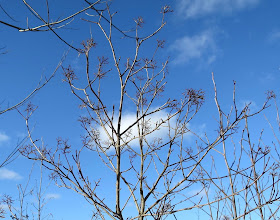A sunny day at last! Has it really been gloomy and gray for days on end, or was I just feeling down because of my dear kitty's passing? At any rate, today was a great day to go walking, so I headed out to Bog Meadow just east of Saratoga. Although the trail was ice-covered, the going was easy with Yaktrax on my boots. My only challenge today was going to be finding something to pique a naturalist's interest. Obviously, I wasn't going to find any flowering plants, nor was I going to track any animal's trail through the snow. Maybe I'll find some fascinating waterfowl when I reach the open marsh.
Nope. The marsh was still frozen over from shore to shore. No waterfowl out there! Nor did I see or hear any birds of any kind anywhere. All was silent.
So OK, what else can I look for along this wooded wetland trail? How about seeing if I can ID some plants in their winter garb? Here's a shrub I knew at a glance because of the distinctive feathery panicles of pedicels at the tips of its twigs. This is Panicled (or Gray) Dogwood (Cornus racemosa), which, earlier in the year, bore clusters of porcelain white berries, and those pedicels were then bright rosy red. Little color remained this late in the winter.
These knobby clusters are all that's left of wild grapes, after the birds have had their fill.
This is all that's left of a Canada Lily's seed pod (Lilium canadense), borne erect now, although the flowers dangled downward when blooming. The neatly stacked seeds have all fallen away, but a few traces remain of the dainty stitches that once held the pod together.
This tight cluster of gaping Pac-Men is what remains of a stalk of White Turtlehead flowers (Chelone glabra).
The small white flowers of Virgin's Bower (Clematis virginiana) are pretty enough, but when they go to seed they explode into feathery clusters far more dramatic than the flowers ever were. I love how the filaments of these persistent puffs glisten in the sun.
I think there's something really elegant about the spore stalks of Sensitive Fern (Onoclea sensibilis), especially when their tight rows of dark beads are silhouetted against the white snow in the swamp.
Adding color to the otherwise muted landscape were thickets of Red Osier Dogwood (Cornus sericea), the bark a startling red and speckled with pin dots.
The buds of Red Maple trees (Acer rubrum) are plump and colorful now, reminding us that spring is on its way.
I was surprised to see some clusters of berries still dangling from the branches of Poison Sumac (Toxicodendron vernix), since these fruits are a valuable food source for birds. If you stay on the trail at Bog Meadow, you are unlikely to come into contact with the toxic oil of this shrub, since it much prefers the deep damp of the swamp where humans seldom tread. Because the swamp is frozen now, I was able to approach this tree to take the photo.
The birds have definitely eaten most of the fruits of Winterberry (Ilex verticillata) by now, so I was quite surprised to come upon a shrub with a single berry remaining.
When I left the trail to follow the bank of a stream back into the swamp, I came upon a patch of bright-green Atrichum moss, and protruding above the moss were a number of tightly-furled Skunk Cabbage spathes (Symplocarpus foetidus). Lest I indulge a false hope that these early shoots signaled an early spring, I reminded myself that Skunk Cabbage sent up these shoots last fall, so they are not recently risen. And mosses stay green all winter. In a normal winter, these plants would be buried beneath several feet of snow. Ah, but when did we last have a "normal" winter, with deep snow covering the ground?













You have such an eye for beauty in the most minute things. Enjoyed every picture.
ReplyDeleteHow wonderful that you were able to find so many delights, even on a such closed up, brittle, winter day. One thing about an open winter like this...you get to see things that might otherwise be inaccessible.
ReplyDeleteWell, they'd be under lots of snow here!
ReplyDeleteCongratulations on finding so many interesting things on one day of what has been a dreary almost snow-less winter.
ReplyDelete